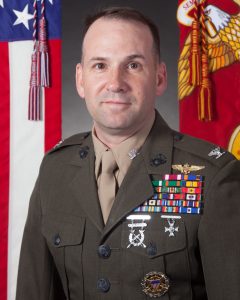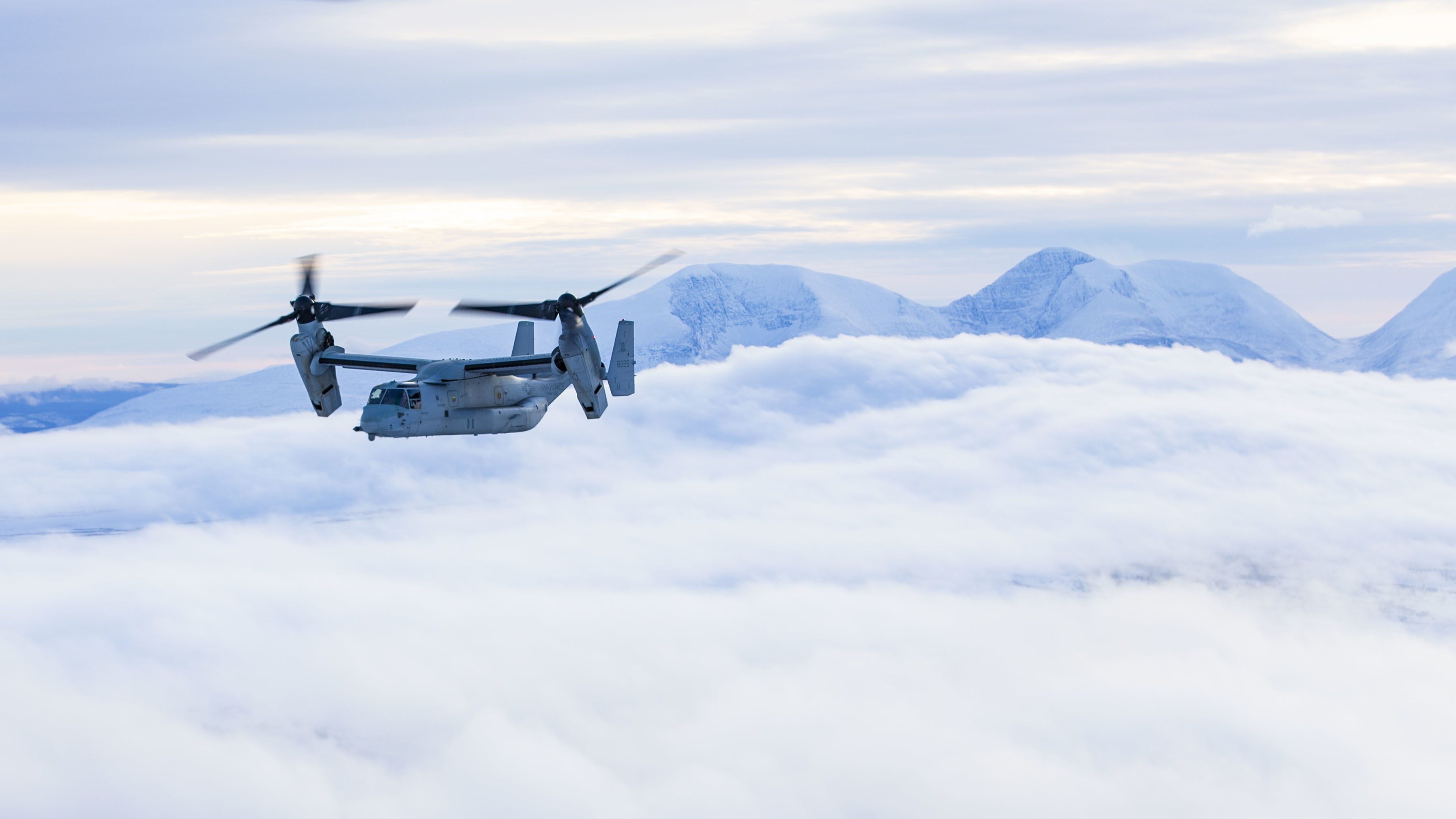By Robbin Laird
During my visit to 2ndMAW in January 2019, I had a chance to talk with the Commanding Officer of MAG-26, Colonel Boniface.
I have had the opportunity to talk with Chris Boniface several times since we first met at the Bold Alligator exercises almost a decade ago.
We have published several interviews with him, and we recently posted an article providing a compilation of his comments over the years as well on defense.info.
https://defense.info/interview-of-the-week/colonel-boniface-on-osprey-enabled-usmc-ops/
It has been a couple of years since I last visited with the Osprey community at New River, and the discussion with Colonel Boniface provided some significant updates on their activities.
We discussed a number of key developments.
First, the Marines like the other services have been hit with significant readiness challenges rooted in the sequestration period.
High tempo ops continued while support dollars were significantly reduced. This is hardly a recipe for success.

Col. Boniface: “When I got here about a year and a half ago, the goal was to basically recover readiness. We’ve had every squadron has either deployed, deploying, or come home.
“And, with that being said, we also saw a significant dip in readiness. We’ve seen about an 85 percent increase in availability of aircraft over the last year and a half.”
Second, while the restoration of support dollars is clearly underway, the challenge is to put in place a more effective support approach to the Osprey fleet which is seeing new users put in place as well as the opportunity to put more effective global support in place as well. In other words, enhanced financial support clearly is a necessary but not sufficient condition to get the support enterprise right.
“One of the biggest challenges that I have here is mitigating the long term down process.
“My problems aren’t necessarily operational.
“My problems are an insufficient supply system and a significant amount of corrosion that I have on some of these aircraft.
“The corrosion piece is being addressed but the corrosion piece takes awhile to get the engineers to come back and say that this aircraft is good.
“But, we don’t have a suitable amount of the engineers and engineering support to be able to turn these corrosion problems and fix them quick enough and turn them into available aircraft.”
There is a significant opportunity to think through what the next round of logistical sustainment for the Osprey fleet could be.
As Col. Boniface put it: “We need better predictability, forecasting, and availability of parts. It’s very difficult to identify where your next supply shortfall is coming from and that’s where this community struggles.”
I added the comment that somebody needs to be thinking through the re-crafting the sustainment enterprise so that the money is put into non-repeatable mistakes and ensures a more predictable and sustainment logistics support enterprise.
There clearly is a need for a healthy supply system built on supporting global operational realities and this challenge will become even more significant with the strategic shift in operations underway.
Col. Boniface added: “We just need a better supply model which can level out the supply chain support to the deployed force.”
Third, when I first visited New River several years ago and talked with the Osprey training squadron, there major focus was upon Marines and the Air Force.
Now with the US Navy buying Ospreys as well as the Japanese, there are new stakeholders in the training process, and that training squadron has become a priority effort within MAG-26 for sure.
Fourth, the Osprey is hitting its mid-term life cycle and will need upgrades, which will enable the aircraft to continue being effective going ahead.
And along with upgrades, the challenge of repairs associated with corrosion, a normal challenge for a sea-borne fleet needs to be addressed as well.
Fifth, MAG-26 like other elements of the USMC are facing the challenge of shifting from the Middle East land wars, as a primary focus, to work in regions quite different against peer competitors.
The specific case we discussed was the engagement of MAG-29 in Trident Juncture 2018, where really for the first time for Marines who had operated the Osprey for many years in the Middle East, they had to deal with Cold Weather and the dynamcis of weather in Iceland and in Norway.
According to Col. Boniface: “It is important to note that during the exercise, which encompassed actions in Iceland and Norway, the V-22 operated above the Arctic Circle.
“We were able to deploy, engage and provide presence in the exercise.
“We had to deal with the weather and operating conditions in the region, which are quite different from where our Marines have spent most of their time in the past decade.
“And we need to continue to learn how to operate in those conditions, and to have the domain knowledge of how to exercise patience and timing appropriate to operations in the Nordic region.
“The weather comes in, each fjord has its own weather so to speak and we have to learn patience and how to deal with the second and third order affects which operating in cold weather generates.”
In short, MAG-26 is in good hands but face significant challenges as the force is reworked to deal with the new strategic environment, and one in which a more effective logistical enterprise needs to be put in place for global operations.
As the Navy and the Japanese join the Osprey nation perhaps this will be easier to get done.
Colonel Chris Boniface
MAG-26 Commanding Officer
Colonel Boniface is a 1994 graduate of the University of South Alabama and entered the Marine Corps through the Platoon Leader’s Class Program.
After completing flight training in December 1997, First Lieutenant Boniface was assigned to Marine Medium Helicopter Squadron (HMM) 365, where he served as the Assistant Logistics Officer, Current Operations Officer, and Squadron Weapons and Tactics Instructor. During this tour he completed two deployments with the 26th Marine Expeditionary Unit (MEU) supporting Operations JOINT GUARDIAN and ALLIED FORCE during the 1999 Kosovo War, Turkish earthquake relief operations for Operation AVID RESPONSE, and a 2001-2002 deployment to Afghanistan for Operation ENDURING FREEDOM.
In 2003, Captain Boniface reported to the 4th Marine Expeditionary Brigade (Anti-Terrorism) for duty as the Air Officer. In October of that year, he transferred to the 8th Marine Regiment to serve as the Regimental Air Officer and deployed to Port-au-Prince, Haiti as part of SPMAGTF-8, CJTF Haiti for Operation SECURE TOMORROW.
Major Boniface reported to HMM-264 in September 2004. During this tour he served as the Logistics Officer and deployed to Iraq for Operation IRAQI FREEDOM.
Between deployments, Major Boniface assumed the duties of the Squadron’s Aviation Maintenance Officer, and in January 2007, deployed with the 26th MEU to the U.S. Central Command area of responsibility.
Upon completing his second deployment with HMM-264, Major Boniface reported to Marine Medium Tiltrotor Training Squadron (VMM) 204 for training on the MV-22 Osprey. After his initial training, he remained onboard as an instructor pilot and Fleet Projects Officer before assisting in the stand-up of VMM-264 as the Operations Officer.
Following his selection to command, Lieutenant Colonel Boniface was directed to report to VMM-266 to serve as the Executive Officer and subsequently deployed with the 26th MEU. During this deployment he participated in Operations ODYSSEY DAWN and UNIFIED PROTECTOR off the coast of Libya.
From May 2011 until December 2013, Lieutenant Colonel Boniface commanded VMM-266. During his command tour, VMM-266 (REINFORCED) deployed as the Aviation Combat Element, 26th MEU to the U.S. Central Command, U.S. Africa Command, and U.S. European Command areas of responsibility.
Before taking command of MAG 26, Colonel Boniface served as the Branch Chief of the Iran Division on the Joint Staff, Strategic Plans and Policy (J-5), Middle East Directorate.
Colonel Boniface is a 2003 graduate of the Expeditionary Warfare School, a 2008 graduate of the Marine Corps Command and Staff College, and a 2015 graduate of the National War College.
For Col. Boniface then Lt. Col. Boniface’s prescient forecast of the impact of the evolution of Marine Corps innovation on the MAGTF, see the following:
The video is from March 3, 2012.


